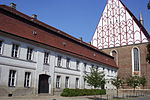Carl-Philipp-Emanuel-Bach-Straße
Germany road stubsRoads in Brandenburg
Carl-Philipp-Emanuel-Bach-Straße is a street in Frankfurt (Oder), Germany. Named after the 18th-century German musician and composer Carl Philipp Emanuel Bach, Carl-Philipp-Emanuel-Bach-Straße is indeed one of the longest street names in the world, certainly Germany.Apart from being very close to the Oder river and the border crossing to Słubice, Poland, Carl-Philipp-Emanuel-Bach-Straße is home to part of the Viadrina Museum in the Junker house and Museum for Junge Kunst.
Excerpt from the Wikipedia article Carl-Philipp-Emanuel-Bach-Straße (License: CC BY-SA 3.0, Authors).Carl-Philipp-Emanuel-Bach-Straße
Carl-Philipp-Emanuel-Bach-Straße,
Geographical coordinates (GPS) Address Nearby Places Show on map
Geographical coordinates (GPS)
| Latitude | Longitude |
|---|---|
| N 52.344936111111 ° | E 14.554813888889 ° |
Address
Carl-Philipp-Emanuel-Bach-Straße
Carl-Philipp-Emanuel-Bach-Straße
15230 , Beresinchen
Brandenburg, Germany
Open on Google Maps











